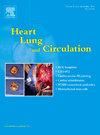Real-World Prescribing of Renal and Cardiovascular Protective Drugs in Patients With Type 2 Diabetes and Chronic Kidney Disease: Analysis of Data From a Western Australian Quaternary Hospital
IF 2.2
4区 医学
Q2 CARDIAC & CARDIOVASCULAR SYSTEMS
引用次数: 0
Abstract
Background
In patients with type 2 diabetes (T2D) and chronic kidney disease (CKD), sodium-glucose cotransporter 2 (SGLT2) inhibitors, semaglutide (glucagon-like peptide-1 [GLP-1] agonist), and finerenone (non-steroidal mineralocorticoid receptor antagonist) improve renal and cardiovascular outcomes. We assessed real-world prescribing of these drugs in patients with T2D and CKD.
Method
The ReDiCare project retrospectively identified patients with T2D and CKD admitted to an Australian hospital between January 2020 and September 2024 using International Statistical Classification of Diseases and Related Health Problems 10th Revision Australian Modification codes. CKD was also defined as an estimated glomerular filtration rate (eGFR) <60 mL/min/1.73 m2 for >3 months. Patients with an eGFR <15 mL/min/1.73 m2, acute kidney injury, renal transplant, or those receiving dialysis were excluded. Drugs prescribed at discharge were obtained.
Results
Of 2,216 patients (mean age 78.2±10.9 years and 41.3% female), an angiotensin-converting enzyme inhibitor or angiotensin receptor blocker was prescribed in 1,243 (56.1%) patients, an SGLT2 inhibitor in 472 (21.3%), a GLP-1 agonist in 163 (7.4%), and a mineralocorticoid receptor antagonist in 305 (13.8%). Specifically, semaglutide was prescribed in 79 (3.6%) patients and finerenone in three (0.1%). Overall, 735 (33.2%) patients were prescribed none, 919 (41.5%) one, 433 (19.5%) two, 115 (5.2%) three, and 14 (0.6%) all four drug groups. From January to March 2020 to July to September 2024, there was an increased prescribing of SGLT2 inhibitors (7.9%–38.7%; p<0.001) and GLP-1 agonists (6.3%–11.7%; p=0.007).
Conclusions
In patients admitted to the hospital with T2D and CKD, one-quarter were prescribed an SGLT2 inhibitor and/or a GLP-1 agonist at discharge. Further studies are required to identify barriers and enablers to prescribing these drugs.
现实世界中2型糖尿病和慢性肾病患者的肾脏和心血管保护药物处方:来自西澳大利亚第四医院的数据分析
背景:在2型糖尿病(T2D)和慢性肾脏疾病(CKD)患者中,钠-葡萄糖共转运蛋白2 (SGLT2)抑制剂、半马甲肽(胰高血糖素样肽-1 [GLP-1]激动剂)和芬纳酮(非甾体矿物皮质激素受体拮抗剂)可改善肾脏和心血管预后。我们评估了现实世界中T2D和CKD患者使用这些药物的情况。方法:ReDiCare项目回顾性分析了2020年1月至2024年9月期间在澳大利亚一家医院住院的T2D和CKD患者,使用国际疾病和相关健康问题统计分类第十次修订澳大利亚修改代码。CKD也被定义为肾小球滤过率(eGFR) 2的估计,持续bbbb3个月。eGFR 2、急性肾损伤、肾移植或接受透析的患者被排除在外。出院时服用处方药物。结果:在2216例患者(平均年龄78.2±10.9岁,女性41.3%)中,1243例(56.1%)患者使用血管紧张素转换酶抑制剂或血管紧张素受体阻滞剂,472例(21.3%)患者使用SGLT2抑制剂,163例(7.4%)患者使用GLP-1激动剂,305例(13.8%)患者使用矿化皮质激素受体拮抗剂。具体来说,79例(3.6%)患者使用了semaglutide, 3例(0.1%)患者使用了finerenone。总体而言,735例(33.2%)患者未使用任何药物,919例(41.5%)使用一种药物,433例(19.5%)使用二种药物,115例(5.2%)使用三种药物,14例(0.6%)使用四种药物。从2020年1月至3月到2024年7月至9月,SGLT2抑制剂的处方增加(7.9%-38.7%);结论:在住院的T2D和CKD患者中,四分之一的患者在出院时使用SGLT2抑制剂和/或GLP-1激动剂。需要进一步的研究来确定处方这些药物的障碍和促成因素。
本文章由计算机程序翻译,如有差异,请以英文原文为准。
求助全文
约1分钟内获得全文
求助全文
来源期刊

Heart, Lung and Circulation
CARDIAC & CARDIOVASCULAR SYSTEMS-
CiteScore
4.50
自引率
3.80%
发文量
912
审稿时长
11.9 weeks
期刊介绍:
Heart, Lung and Circulation publishes articles integrating clinical and research activities in the fields of basic cardiovascular science, clinical cardiology and cardiac surgery, with a focus on emerging issues in cardiovascular disease. The journal promotes multidisciplinary dialogue between cardiologists, cardiothoracic surgeons, cardio-pulmonary physicians and cardiovascular scientists.
 求助内容:
求助内容: 应助结果提醒方式:
应助结果提醒方式:


